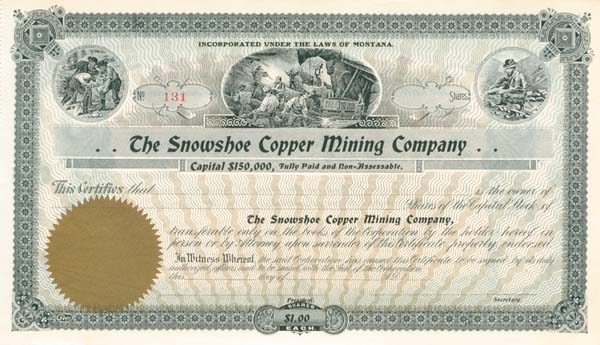Snowshoe Copper Mining Co. - Unissued Stock Certificate
Inv# MS1635 Stock
Unissued Stock printed by Goes.
Snowshoe Lake is a small alpine lake located in the Cabinet Mountains in northwestern Montana. It is within the boundaries of Kaniksu National Forest. Snowshoe Peak overlooks the lake. Granite Lake and Leigh Lake are also located nearby.
Various indigenous peoples lived in the territory of the present-day state of Montana for thousands of years. Historic tribes encountered by Europeans and settlers from the United States included the Crow in the south-central area, the Cheyenne in the southeast, the Blackfeet, Assiniboine, and Gros Ventres in the central and north-central area, and the Kootenai and Salish in the west. The smaller Pend d'Oreille and Kalispel tribes lived near Flathead Lake and the western mountains, respectively. A part of southeastern Montana was used as a corridor between the Crows and the related Hidatsas in North Dakota.
As part of the Missouri River watershed, all of the land in Montana east of the Continental Divide was part of the Louisiana Purchase in 1803. Subsequent to and particularly in the decades following the Lewis and Clark Expedition, European, Canadian and American traders operated a fur trade, trading with indigenous peoples, in both eastern and western portions of what would become Montana. Though the increased interaction between fur traders and indigenous peoples frequently proved to be a profitable partnership, conflicts broke out when indigenous interests were threatened, such as the conflict between American trappers and the Blackfeet. Indigenous peoples in the region were also decimated by diseases introduced by fur traders to which they had no immunity. The trading post Fort Raymond (1807–1811) was constructed in Crow Indian country in 1807. Until the Oregon Treaty of 1846, land west of the continental divide was disputed between the British and U.S. governments and was known as the Oregon Country. The first permanent settlement by Euro-Americans in what today is Montana was St. Mary's, established in 1841 near present-day Stevensville. In 1847, Fort Benton was built as the uppermost fur-trading post on the Missouri River. In the 1850s, settlers began moving into the Beaverhead and Big Hole valleys from the Oregon Trail and into the Clark's Fork valley.
The first gold discovered in Montana was at Gold Creek near present-day Garrison in 1852. Gold rushes to the region commenced in earnest starting in 1862. A series of major mineral discoveries in the western part of the state found gold, silver, copper, lead, and coal (and later oil) which attracted tens of thousands of miners to the area. The richest of all gold placer diggings was discovered at Alder Gulch, where the town of Virginia City was established. Other rich placer deposits were found at Last Chance Gulch, where the city of Helena now stands, Confederate Gulch, Silver Bow, Emigrant Gulch, and Cooke City. Gold output between 1862 and 1876 reached $144 million, after which silver became even more important. The largest mining operations were at Butte, with important silver deposits and expansive copper deposits.
A stock certificate is issued by businesses, usually companies. A stock is part of the permanent finance of a business. Normally, they are never repaid, and the investor can recover his/her money only by selling to another investor. Most stocks, or also called shares, earn dividends, at the business's discretion, depending on how well it has traded. A stockholder or shareholder is a part-owner of the business that issued the stock certificates.









Ebay ID: labarre_galleries